Editorial: Animal Kinship Committee Position Statement
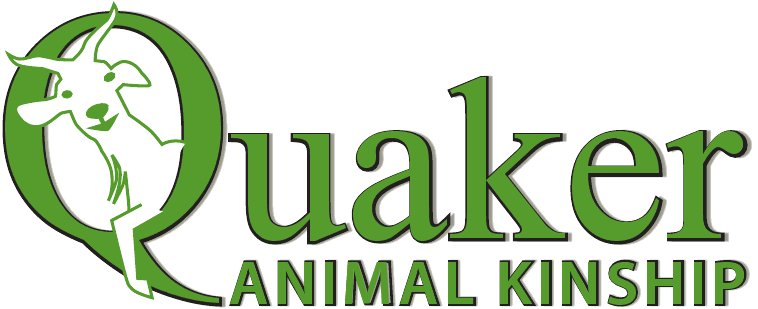
Some of our readers may want to know more about the Animal Kinship Committee, sponsor of PT. Recently we were asked by members of our Meeting to write up a summary of our position for the benefit of other Friends. Since we will need a Position Statement in other contexts as well, and since our view of our task has been evolving somewhat over the years, we offer the following as a work in progress. We invite readers' comments.
In an often-quoted passage, John Woolman says "May we look upon our treasures and the furniture of our houses and the garments in which we array ourselves and try whether the seeds of war have any nourishment in these . . ." Woolman, as we know, practiced what he preached, scrutinizing taken-for-granted customs and opinions, braving social discomfort for himself and others by gently declining to participate in any that promoted slavery or the luxury/poverty split between social classes.
Since its beginning in 1992, the Animal Kinship Committee has encouraged Friends and others to look particularly upon the food on our tables to see if the seeds of violence and destruction have nourishment there. We see many signs that they do.
Basis of the Concern of the Animal Kinship Committee
The present system of animal husbandry in the United States has largely swallowed up independent family farms, reducing to "sharecroppers" some that remain. It is now agribusiness, with a few giant companies controlling billions of animals imprisoned in “factory farms.” The system involves makers of cages, pharmaceutical companies, transport systems, slaughterhouses (or rather slaughterhells), supermarket chains, advertisers, lobbyists, and consumers. The wealth of the companies gives them great power to manipulate political policies and public opinion, so that they can serve their own interests, often at the cost of the people and the planet. The size of the system and its methods are gravely harming human beings, animals, and the earth.
 1. Environment: The system contributes in several ways to threats to our environment. It uses up vast amounts of fresh water from shrinking aquifers. It is a major water polluter. It releases excess nitrous oxide and methane into the air. It contributes to deforest- ation and desertification in the U.S. and in Latin American countries, speeding global warming, and thus destructive climate change.
1. Environment: The system contributes in several ways to threats to our environment. It uses up vast amounts of fresh water from shrinking aquifers. It is a major water polluter. It releases excess nitrous oxide and methane into the air. It contributes to deforest- ation and desertification in the U.S. and in Latin American countries, speeding global warming, and thus destructive climate change.
2. Distributive Justice: The system greatly worsens hunger in impoverished countries because between a third and a half of the grains produced in the world are fed to animals destined to be eaten mostly in rich countries. In the process, the total amount of available food is reduced, and we have a growing luxury/poverty split.
3. Human Health: Callous agribusiness practices have produced low-cost products; this, together with saturation advertising often posing as health education, has led us to adopt a diet heavy in meat, dairy, and eggs, a diet which tends to harm our health. To make matters worse, the products are laced with harmful pesticides, antibiotics, and hormones, and are often dangerously unsanitary. Many studies show that in societies whose diet is mostly plant-based, our major cancers, coronary heart disease, and other degenerative diseases are rare. But when members of these cultures adopt a Western diet and lifestyle, the rate of these diseases rises. Many authorities now agree that one can be quite healthy without any meat.
4. Compassion: The animals which the system exploits suffer greatly at almost every stage of the process: selective breeding which causes their bodies to become more and more painful as they grow; traumatic separation of mothers and newborns; massacre of male infants by the egg and dairy industries; the cutting off of beaks and tails; crowded confinement in filth and polluted air; miserable transportation without food and water in crowded trucks; and finally being killed in terror, often in agony, in the slaughterhells.
5. Evasion: Caring persons who would be moved to compassion by seeing defenseless and innocent fellow beings suffering so greatly are spared the sight and sounds of it by thick windowless walls, barbed wire, and a vocabulary sugared with euphemisms.
All five of these dimensions implicitly conflict with Friends’ Testimonies. Our Peace testimony is especially important here. The harm done to the environment is violence against the planet, our home, and its present and future peoples. The callous treatment of the animals is violence against them throughout their lives as well as at their deaths, and it degrades those who carry it out. Most consumers would not do or support such cruel acts on their own, but because we inherit the system unthinkingly we are numbed to it rather than moved by the loving kindness our Inner Light naturally inspires. That the system's ugliness is kept out of sight and masked by language designed to mislead violates the Truth/Integrity testimony. Because these animal products take their toll on the environment, our bodies, and the poor, and we do not need them, they are luxuries that violate the testimonies of Simplicity and Equality.
The Work of the Animal Kinship Committee
The Committee seeks to raise the consciousness of Friends and other people of faith about the inherent wrongs of animal husbandry as a form of slavery, and especially the many evils of the animal agribusiness system; to encourage people to withdraw their support from it, and move toward a diet that is compassionate, sustainable, and fair. To do so is to implement a charge to Friends in the Global Climate Change Minutes adopted in 2007 by both Orange Grove Meeting and Pacific Yearly Meeting, which reads:
We call for Friends to examine and decrease our individual impacts, where possible, so that Earth’s resources are sustained or replenished. Such commitments will likely entail major adjustments in our purchases, diets, transportation, and livelihoods.
For the past eight years, the Committee have met faithfully on the third Sunday of the month at 1:00 PM at Kate Carpenter’s house in Pasadena. We have a vegan potluck with anywhere from five to ten people participating, after which we do business. The meal and meeting are more like a celebration than work, and we enjoy them. All are welcome.
The work of Animal Kinship goes beyond Orange Grove Meeting to reach out to others, especially other people of faith. We network with like-minded organizations, working particularly closely with Fauna Outreach, a locally-based nonprofit that provides free spay and neuter services for feral cats and companion animals of low-income families. We table at Pacific Yearly Meeting of Friends and at various conferences, where we distribute, among other literature, our booklet “Are Animals Our Neighbors?” We are presently pursuing nonprofit status. (The booklet, which is reviewed in PT 21 (see Review), is available free for distribution.)
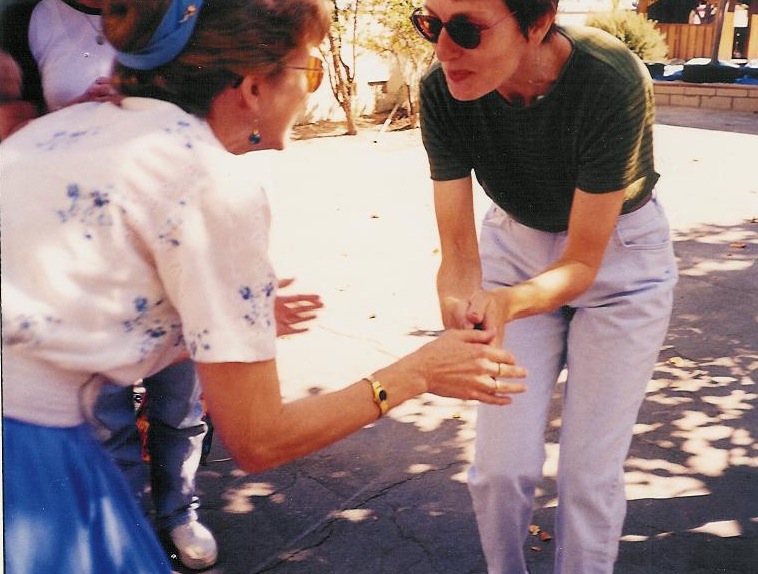
Part of our ministry is providing vegan food for Meeting events or Meeting-related events. Occasionally we have fundraising bake sales, sometimes as benefits for like-minded groups. Once or twice each year we have a vegan cooking class, which has always been well attended and enjoyed.
Since July 2004 we have published our free monthly on-line journal, The Peaceable Table. At present we have over 550 subscribers, a good number of them from other denominations. They receive a monthly letter describing the contents of the current issue, together with a link.
In the spirit of John Woolman, let us courageously hold this important area of life in the Light of Truth, following the leadings of the Spirit that seeks to enlarge our hearts to love for all beings.
--Gracia Fay Ellwood and Kate Carpenter
The photo, taken about 1998, shows Gracia Fay (left) and Kate participating in an inter-generational animal charades game in the Meeting yard.
Unset Gems
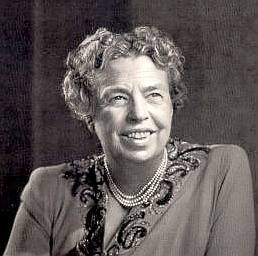 "Courage is more exhilarating than fear and in the long run easier.
"Courage is more exhilarating than fear and in the long run easier.
We do not have to become heroes overnight, just a step at a time,
meeting each thing as it comes up . . . " --Eleanor Roosevelt
--Contributed by Sally Campbell
"Awareness is bad for the meat business. Conscience is bad for the meat business. Sensitivity to life is bad for the meat business. DENIAL, however, the meat business finds indispensable."--John Robbins, Diet for a New America
--Contributed by Lorena Mucke
In a "Frank and Ernest" cartoon, a sign in front of a vegan restaurant reads: "Come on in and eschew the fat."
-Contributed by Benjamin Urrutia
News Notes
Mainstream Concern About CAFO Antibiotics
On February 9 and 10, CBS Evening News reported on the overuse of antibiotics in food animal production in the US. In spite of the overwhelming evidence that this overuse puts human health at risk, the meat industry defends it on the grounds of cost vs. profit. To watch excerpts from both programs see Antibiotic Overuse .
--Contributed by Lorena Mucke
Mainstream Appeal of Animal Friendship
The Super bowl telecast this year had a Budweiser ad featuring a scene of friendship between a calf and colt. Three years later, when the calf has become a bull grazing by the side of the road, along comes the team of Budweiser horses, with the onetime colt in the lead. The bull recognizes his old buddy and breaks though the fence to trot alongside him. Two guys comment that nothing, especially fences, can come between two real friends.
It's encouraging that this staged "glimpse of the Peaceable Kingdom" would be created to sell beer to middle-of-the-road football fans.
--Contributed by Sally Campbell
A Glimpse of the Peaceable Kingdom
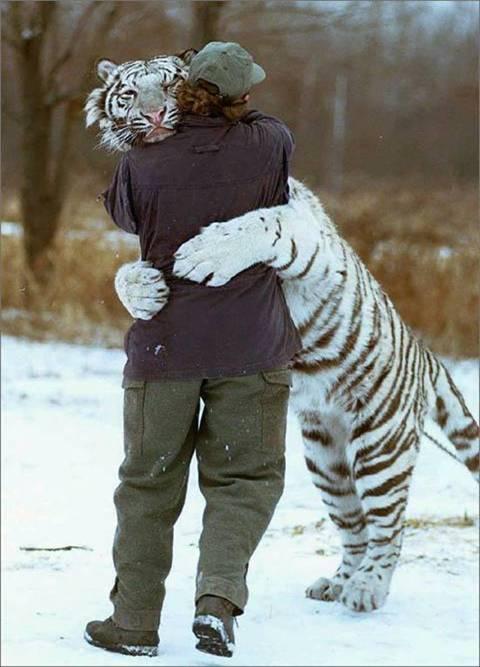 --Contributed by Barbara Booth
--Contributed by Barbara Booth
A person named Simon says this picture was taken in Vancouver, Canada, in 1999, by a Swedish couple; he identifies the man in the picture as his friend Gary Ayliffe. See Tiger Hug
One of our readers, who worked in a big-cat sanctuary, commented that this picture made her want to hug a tiger--but that adult tiger-hugs are dangerous for humans. Her letter will appear in the April issue.
Moral: Don't hug your tiger today. (Try a domestic kitty from the shelter!)
Recipes
Easy and Simple Bowl of Miso Soup
Serves 1
2 tsp. Mellow White Miso (Miso Master® Organic Mellow White is quite good)
1 tsp. soy sauce or Tamari
½ tsp. seasoned rice vinegar
1 slice fresh ginger, peeled and grated
½ cup fresh or frozen organic green peas
2 stalks fresh or frozen organic asparagus, cut into one inch pieces
1 small organic carrot, peeled and grated
1 organic scallion, sliced
1 small clove garlic, peeled and minced
½ cup cooked jasmine or sushi rice
¼ tsp. red pepper flakes
2 cups boiling spring or filtered water
Heat water in tea kettle on high. While water is heating, place all other ingredients in soup bowl. Mash the miso, so it will dissolve easily in the water. Pour boiling water over ingredients, stir to blend well. Cover and allow flavors to blend for 5 – 8 minutes. Stir again and serve with rice crackers.
Use wheat free tamari or soy sauce for a delicious gluten free lunch.
--- Angela Suarez
Chocolate Walnut Cake
Makes one 9 inch round cake
1 cup walnut pieces
⅓ cup canola or safflower oil
¾ cup evaporated cane juice (vegan granulated sugar)
¼ + 2 T. cocoa powder
2 T. brandy
1 tsp. baking powder
¼ tsp. baking soda
¼ tsp. sea salt
1 ¼ cup unbleached flour
1 ¼ cup vanilla soymilk
Preheat oven 350° F.
Place walnuts in bowl of food processor; process to form a meal. Add oil, sugar, cocoa, brandy, baking powder, baking soda, flour and soymilk. Process until smooth. Pour into a greased 9 inch spring form cake pan. The batter should not be too thin, but fairly pourable. Use a rubber spatula to scrape all the contents of the processor bowl into the spring form pan.
Bake for 35 - 40 minutes until toothpick comes out clean. Cool for several minutes; open spring form pan. When cool remove bottom of spring form pan and place on serving plate. Serve with afternoon tea or coffee.
This cake is delicious and very moist, thanks in part to the ground walnuts. It mixes so easily in the bowl of the food processor. It is especially delicious with whipped soy cream (Soyatoo® Soy Whip Topping, made with organic soy, is just perfect) and red raspberries.
To learn more about Soyatoo Soy Whip, see Soy Whip .
--- Angela Suarez
Pioneer: Leonie Van Gelder
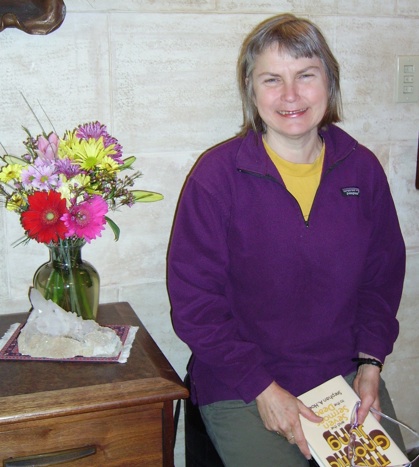
Rooted in Compassion
My roots as an ovo-lacto vegetarian go back three generations. As a young man living in the Netherlands in the 1890’s, my grandfather became a member of the Theosophical Society, an organization dedicated to promoting the brotherhood of humanity and the unity of life. Compassion for all beings is one of its central tenets. Like many members, he believed that it was unnecessary and cruel to eat animals, and so chose to become a vegetarian. He moved to Indonesia where he met my grandmother; soon afterwards, both she and her mother also became vegetarians (thus one might say my family has been veg for four generations).
My grandparents married in 1902, and raised their children as vegetarians. They were fortunate to be living for much of the first half of the twentieth century in Asia, where vegetarianism was a very acceptable way of life. They did live for a number of years in Australia,where they may have been viewed as odd by the general population. But there they associated closely with other members of the Theosophical Society who were also vegetarians, and who supported them.
My father remained committed to vegetarianism all of his life, although I believe that during World War II when he was a soldier involved in the invasion of Normandy, he had to compromise to some degree. It was during this period of time that he met and married my mother. She also adopted a vegetarian lifestyle, though in the early years of their marriage she would on occasion eat fish.
My parents in turn raised their six children as vegetarian; I am the youngest, born in Vancouver, Canada, in 1954. Again, our dietary commitment wasn’t a very common lifestyle. We were perceived as being different, but, as with my grandparents in Australia, we had the support of a community of like-minded people, since we knew quite a few vegetarian members of the Theosophical Society.
As a child and adolescent I was quite shy and I felt a little awkward because my diet made me different. I have some vivid memories from that time. In the first grade, I was once invited to one of my school friends' house for lunch. Because of my shyness, I failed to explain to my friend that I was a vegetarian, so when I got to her house and we were seated at the table, her mother served us chicken noodle soup. At this point I finally piped up, “I can’t eat this because I am a vegetarian.” The mother was taken a little off guard, but she quickly adapted to the situation and made me a peanut butter and jelly sandwich.
Over time, our neighbors and friends grew accustomed to our food choices and were quite adaptable when we came over for meals or snacks. This, of course didn’t stop a couple of my childhood buddies from picking an argument with me, claiming that cows would overrun the world if we didn’t eat them. I didn’t quite know how to reply, except to say that it wasn’t true. When I reported these arguments to my parents they would laugh and give me tips on what to say back.
Another experience that sticks out in my mind occurred when I was learning fractions in elementary school. One of the problems asked if I would rather have 2/3 or 3/4 of a hot dog. This was a very serious question for me; it was obvious that I needed to take the smallest possible amount of the objectionable hot dog. I took almost the whole time working out and rechecking this one problem. I came up with the right answer for me—2/3, of course--but it was marked wrong. For some reason the teacher was calling up students to the front of the class to redo problems that they answered incorrectly. I was called and I redid the problem—again correctly, proving that 2/3 was less than 3/4. When the teacher asked why I choose the lesser amount, I told her it was because “I am a vegetarian.” (I don’t remember if she marked me right or wrong.)
As I grew into my teens, I no longer shied away from telling people that I was a vegetarian, but in the late 1960’s and early 1970’s some people had strange ideas and believed a vegetarian diet was unhealthy. This is the case even now; it was just a few years ago that I had a premed student tell me that people who ate at McDonald's got better nutrition than I did, and I eat a fairly balanced diet. It seems to me that nutritional science and mainstream medicine have been pretty slow in catching up with the truth of of what healthy food is.
This calls to mind another amusing memory. In high school I had a home economics teacher who claimed that a vegetarian diet didn’t contain enough protein, and that vegetarians were thus listless and lethargic. I don’t think her remark was pointed at me because at this point she didn’t know that I was a vegetarian. But as it happened, I was incredibly bored in the class, and because it was right after lunch, I generally felt drowsy. After this comment, though, I felt duty bound to be energetic! Needless to say, for the rest of term, I made the effort to be “bright-eyed and bushy-tailed.”
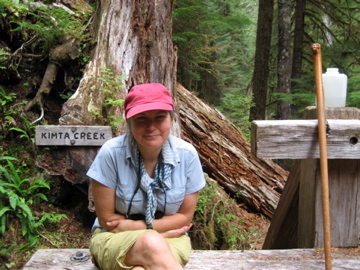
Today, I am still an ovo-lacto vegetarian and have no problem declaring it. I have never knowingly eaten meat, although I am pretty sure, even though I am very careful, that I have probably consumed a little here and there hidden in other foods. I have come to realize that people don’t always read labels, and that not everybody is conscientious about what they add to supposedly meatless dishes.
I never had to give up anything to be a vegetarian, so on the whole, it has been pretty easy for me. I know that I could take some further steps, as both the humane and health values of the vegan diet have been made quite apparent.
"Compassion and love are not mere luxuries. As the source both of inner and external peace, they are fundamental to the continued survival of our species."--Tenzin Gyatso, the 14th Dalai Lama
The first photo shows Leonie in the library at the Krotona Institute; the photographer is Lakshmi Narayan. The second, taken by Minor Lyle, shows her during a hike in Washington's Olympic Peninsula.
The Peaceable Table is
a project of the Animal Kinship Committee of Orange Grove Friends Meeting, Pasadena, California. It is intended to resume the witness of that excellent vehicle of the Friends
Vegetarian Society of North America, The Friendly
Vegetarian, which appeared quarterly between 1982 and
1995. Following its example, and sometimes borrowing from its
treasures, we publish articles for toe-in-the-water
vegetarians as well as long-term ones.
The journal is intended to be
interactive; contributions, including illustrations, are
invited for the next issue. Deadline for the April issue
will be Mar. 28, 2010. Send to graciafay@gmail.com
or 10 Krotona Hill, Ojai, CA 93023. We operate primarily
online in order to conserve trees and labor, but hard copy
is available for interested persons who are not online.
The latter are asked, if their funds permit, to donate $12 (USD) per year. Other
donations to offset the cost of advertising (in The Christian Century) are welcome.
Website: www.vegetarianfriends.net
Editor: Gracia Fay Ellwood
Book and Film Reviewers: Benjamin Urrutia & Robert Ellwood
Recipe Editor: Angela Suarez
NewsNotes Editors: Lorena Mucke and Marian Hussenbux
Technical Architect: Richard Scott Lancelot Ellwood

 1. Environment: The system contributes in several ways to threats to our environment. It uses up vast amounts of fresh water from shrinking aquifers. It is a major water polluter. It releases excess nitrous oxide and methane into the air. It contributes to deforest- ation and desertification in the U.S. and in Latin American countries, speeding global warming, and thus destructive climate change.
1. Environment: The system contributes in several ways to threats to our environment. It uses up vast amounts of fresh water from shrinking aquifers. It is a major water polluter. It releases excess nitrous oxide and methane into the air. It contributes to deforest- ation and desertification in the U.S. and in Latin American countries, speeding global warming, and thus destructive climate change. 
 "Courage is more exhilarating than fear and in the long run easier.
"Courage is more exhilarating than fear and in the long run easier.
 --Contributed by Barbara Booth
--Contributed by Barbara Booth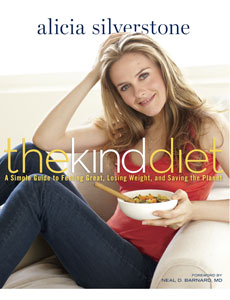 Kind Diet. A Simple Guide to Feeling Great, Losing Weight, and Saving the Planet. By Alicia Silverstone. Photographs by Victoria Pearson. Preface by Paul McCartney. Foreword by Neil Barnard, MD. New York: Rodale, 2009. 308 pages hardcover. $29.99 ($35.99 in Canada).
Kind Diet. A Simple Guide to Feeling Great, Losing Weight, and Saving the Planet. By Alicia Silverstone. Photographs by Victoria Pearson. Preface by Paul McCartney. Foreword by Neil Barnard, MD. New York: Rodale, 2009. 308 pages hardcover. $29.99 ($35.99 in Canada).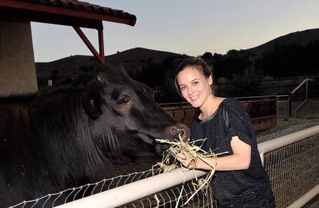 But we would do the author a grave injustice if we thought that looking good is her main concern (though her looks may be the main focus of some of her readers); her focus is on compassion for her animal friends."These animals experience lives tantamount to humans being strapped into straightjackets, locked in cells, abused by jailers, awaiting nothing but death." (p. 30). Such evils are contrary to the convictions that she as a faith-full Jew holds dear, as well they should be. "Every single creature wants to live fully. That's what God designed us to do. That's our purpose." (p. 29).
But we would do the author a grave injustice if we thought that looking good is her main concern (though her looks may be the main focus of some of her readers); her focus is on compassion for her animal friends."These animals experience lives tantamount to humans being strapped into straightjackets, locked in cells, abused by jailers, awaiting nothing but death." (p. 30). Such evils are contrary to the convictions that she as a faith-full Jew holds dear, as well they should be. "Every single creature wants to live fully. That's what God designed us to do. That's our purpose." (p. 29). 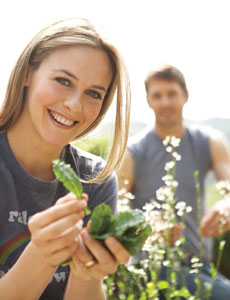 The second half of the book is a vegan cookbook, of interest to amateur and professional cooks and chefs, and useful to new vegetarians. One recipe I really want to try is the one for polenta (Italian-style coarse maize meal).
The second half of the book is a vegan cookbook, of interest to amateur and professional cooks and chefs, and useful to new vegetarians. One recipe I really want to try is the one for polenta (Italian-style coarse maize meal).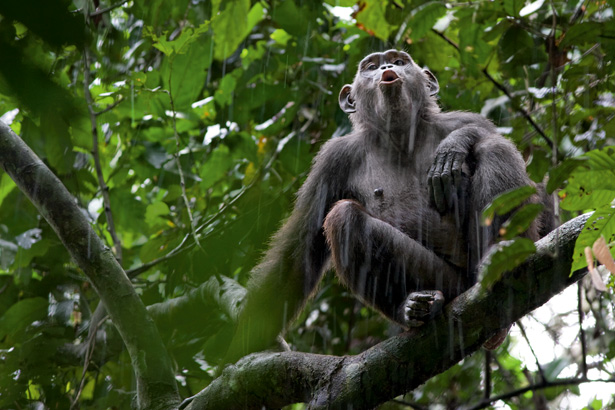


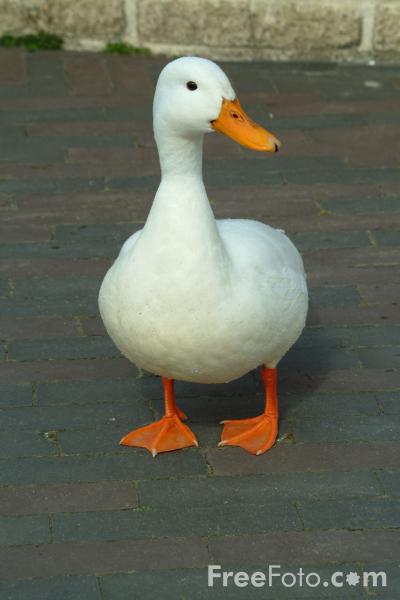 Thanksgiving dinner's sad and thankless
Thanksgiving dinner's sad and thankless